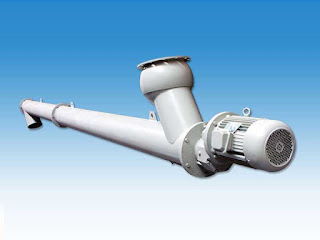 There is a magical machine of screw conveyor, it can be widely used
in chemical, metallurgy, paper making, and construction industries. The
equipment is suitable for field flowing work, such as concrete mixing station,
bulk material transit storage and etc.
There is a magical machine of screw conveyor, it can be widely used
in chemical, metallurgy, paper making, and construction industries. The
equipment is suitable for field flowing work, such as concrete mixing station,
bulk material transit storage and etc.
Here are the basic technical datas:
U-type Screw Conveyor
Model: LS315
Type: U type
Screw diameter: 315mm
Screw pitch: 315mm
Rotating speed: 40/50/63/80rpm
Capacity: 16~34m³/h
For more information, please contact me @skype: wang.betty13 , you can also
send me mails @kewang808.gmail.com
►Brief Introduction
A screw conveyor (also known as spiral conveyors,conveyor screw,auger conveyor)is one of the most versatile and cost effective mechanical conveyors for handling dry bulk solids such as flakes, grains, powders, seeds and granules. The conveyor provides enclosed transfer while moving materials-horizontally, vertically or at an incline and can deliver materials from one or more inlet points to one or more discharge points. It usually consist of a trough or tube containing either a spiral blade coiled around a shaft, driven at one end and held at the other, or a "shaftless spiral", driven at one end and free at the other. Screw conveyors can be operated with the flow of material inclined upward. When space allows, this is a very economical method of elevating and conveying. As the angle of inclination increases, the capacity of a given unit rapidly decreases.
►Working principle
It consists of electric motor driven spiral, which is the only moving part, rotates within a food grade & sealed tube. The material moves along the spiral within the tube. The unique action of the flexible spiral conveyor eliminates the risk of the product separation that can take place in conventional pneumatic conveying systems where mixed materials have components of different densities and particle size.

► Features
1.Simple structure, good sealing, large capacity, long service life.
2.Convenient installation and maintenance, as well as easy operation.
3.Working temperature is -20~50℃, with material temperature below 200℃.
4.The conveying length is up to 70m.
5.Suitable for horizontal and slightly inclined transport of powdery, granular materials.
► Advantage
1.It can be sealed to prevent the escape of dust or fumes from inside the conveyor; or prevent dust contamination from outside the conveyor.
2.It can be used to control the flow of material in processing operations which depend upon accurate batching
3.It can be utilized in the horizontal, vertical or any inclined position depending upon the characteristics of the product being conveyed.
4.It can be used as a mixer or agitator to blend dry or fluid ingredients, provide crystallization or coagulant action, or maintain solutions in suspension.
5.Screw conveyors can have multiple conveyor outlets, making discharge to multiple outlets cost effective.
6.It can be jacketed to serve as a drier or cooler by running hot or cold water through the jacket.
7.It can be made out of a variety of materials to resist corrosion, abrasion or heat, depending upon the product being conveyed.
8.It can be outfitted with multiple inlet and discharge points.
► Applications
It is widely used for chemical, metallurgy, paper making, and construction industries. The equipment is suitable for field flowing work, such as concrete mixing station, bulk material transit storage and etc.
► Maintenance
1.General Inspection
Routine periodic inspection of the entire conveyor must be established to ensure continuous maximum operating performance. Keep the area around the conveyor and its drive clean and free of obstacles to provide easy access and avoid functional interference of components.
2.Power Lock Out
Lock out power to the motor before attempting any maintenance. Use a padlock and tag on the drive’s controls. Do not remove padlock or tag, nor operate conveyor, until all covers and guards are securely in place.
3.Removing Screw Sections
Screw sections are typically removed starting with the end opposite the drive when necessary. Remove trough end, screw sections, coupling shafts, and hangers until damaged or worn section is removed. Reassemble conveyor in reverse order.
4.Coupling Bolts
Periodically remove and inspect one of the drive shaft coupling bolts for damage or wear. Also inspect the coupling bolt hole. The drive shaft coupling bolts transmit more power than successive coupling bolts and will typically indicate the greatest wear. An accurate torque wrench should always be used when tightening coupling bolts. Excessive torque will stretch the bolt and significantly compromise its strength.
5.Lubrication
Lubricate end bearings, hanger bearings and drive components at the frequency and quantity specified by the individual component’s manufacturer. Most types of hanger bearings require lubrication and wear is reduced significantly with a frequent lubrication schedule. Frequency of schedule depends on temperature, type of bearings, type of lubrication, product conveyed, trough load, screw weight, etc.)
6.Screw Bushings/Internal Collars
The bushing at each end of a screw will wear over time. When possible, check for excessive shaft movement that indicates bushings need to be replaced. Longer and heavier screws typically have greater bushing wear.
► Selection condition
Primary considerations for the selection of a screw conveyor are as follow:
1.Type and condition of the materials to be handled, including maximum particle size, and, if available, the specific bulk density of the material to be conveyed.
2.Quantity of transported material, expressed in pounds or tons per hour.
3.The distance for which the material is to be conveyed.
Below is the necessary information for the selection of a screw conveyor system, presented in a series of five steps. These steps are arranged in logical order, and are divided into separate sections for simplicity. The five steps are:
1.Establishing the characteristics of the material to be conveyed.
2.Locating conveyor capacity (conveyor size and speed) on capacity tables.
3.Selection of conveyor components.
4.Calculation of required horsepower.
5.Checking of components torque capacities (including selection of shaft types and sizes)






















